This came up on my Facebook feed today. And it had me in stitches. Apparently it’s been out there aeons (posted 12 years ago!). But this was my first encounter. Really, really, very, very funny. Thank you Stevie Riks!
MUSiC: Vulfmon, Vulfnik

Vulfmon has, so far/as far as I know, been an altar-ego for Vulfpeck’s Jack Stratton for quite some time. Often, or so it’s seemed to me, for slightly more goofy or experimental stuff.
This is – correct me if I’m wrong – his first mini-LP length offering of stuff under that nom-de-plume. A collection of tracks raving from totally solo stuff, to collaborations with numerous other folk. Some of these collaborators I’ve see and heard him work with before (Antwaun Stanley, Jakob Jeffries), others I didn’t recognise.
Vulfmon/Stratton also collaborates here with video makers: there’s the very light/lite or cute/sweet dance competition storyline of ‘UCLA’, and then the much darker but incredibly beautiful ‘Blue’. The whole Stratton/Vulf universe has always had a very powerful unified visual aesthetic. It’s amazing how even in collaboration, and as diverse as this set is, that aesthetic unity, the string flavour, is preserved.
There’s even a ‘dance remix’ style re-working of The Stratton/Jeffries How Much Do You Love Me? Normally I can’t stand this sort of schtick. But they pull it off, with the help of a goofy video.
It’s not easy for me to admit – who likes to be the aloof lone wolf, up on my lonely crag, howling at the world – but I’m a fan! There’s very little Jack does that I don’t really love. Indeed, although I don’t like to concur with … et, um…
The spoken word piece – ‘James Jameson used 1 finger’ – is brilliant. Poetry, philosophy, aesthetics, motivation. And the way he frames himself as a tousle-haired squinting, side-burned Vulfnik guru, with tiny mic and gorgeous if uncomprehending female acolyte?
There’s a simultaneous density and richness that makes for a piquant contrast with the otherwise oft-Spartan low-volume thing.
The only track I’m less sold on is ‘Harry’s Theme (Lite Pullman)’. But even then, it is at least interesting. Vulfmon and co cover an astonishing range of territory here, from the gospel-soused cover, ‘The Lord Will Find A Way’, to ‘I Can’t Party’ or ‘Bonnie Wait, to the funk of ‘Harpejji’, the deeply introspective ‘Blue’ to the effervescent ‘Nice To You’ or
FOR SALE: Hand-Made 13” Hand Drum, £120
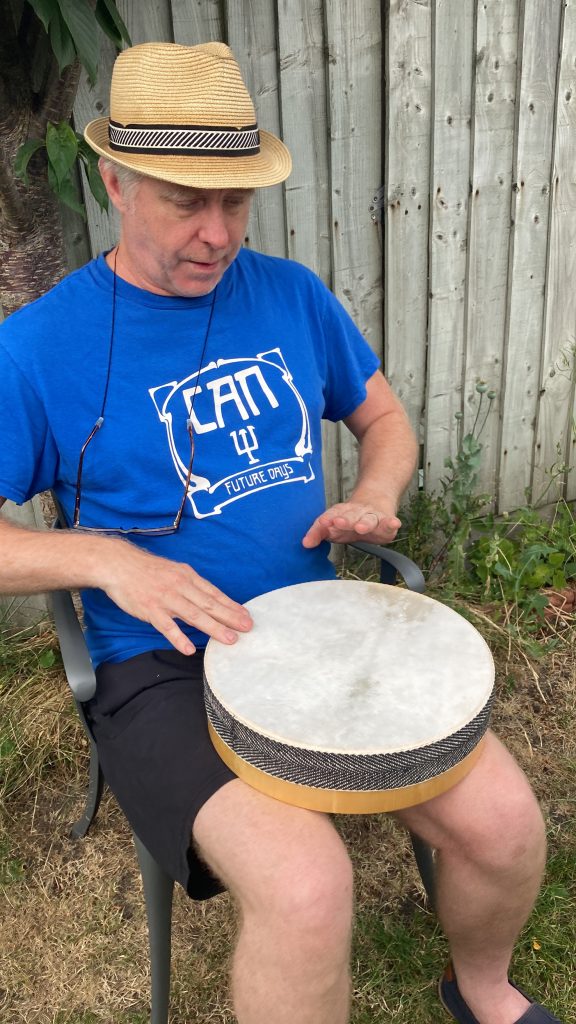
Some while ago Teresa asked me to make a bodhran style drum for one of her service users (a chap called Angus). So, eventually, I did. It was fun. And Angus apparently loves it.
So I decided to make another, for my own use. Both were made from the same old 13” drum-kit tom, stripped of hardware (holes filled!), and the cheap and horrible drum wrap it had previously sported.
Teresa has persuaded me to try selling it. And possibly start doing this as a bit of a low key hobby that might even bring in a bit of money. So I’m going to give it a shot.
Talking of ‘shot’, here are a few very short video clips of me that Teresa shot on my iPhone, in the garden today, attempting to play this drum. I’m a kit drummer, primarily. And I think these videos might reflect that. I ought to play hand drums more. It’s fun!
The above video is kind of holding the drum in a traditional hand drum manner. Some hand drums, like the bodhran, can have wooden beams inside the, across the diameter of the drum. Some times just one (like the I made for Angus), sometime two, 90° to each other. This drum has no such internal beams.
The next three videos I’m playing the drum on my lap. I probably should’ve put it between my knees. To stop it bouncing around and moving. I might do some more practice (and maybe some videos?) in that line.
I’ve advertised the drum on Facebook Marketplace. And I’ll also be putting it up on Etsy, Reverb, eBay, Gumtree, and anywhere else I can.
Annoyingly FB Marketplace limits me to just one video. So I added the following six photos.
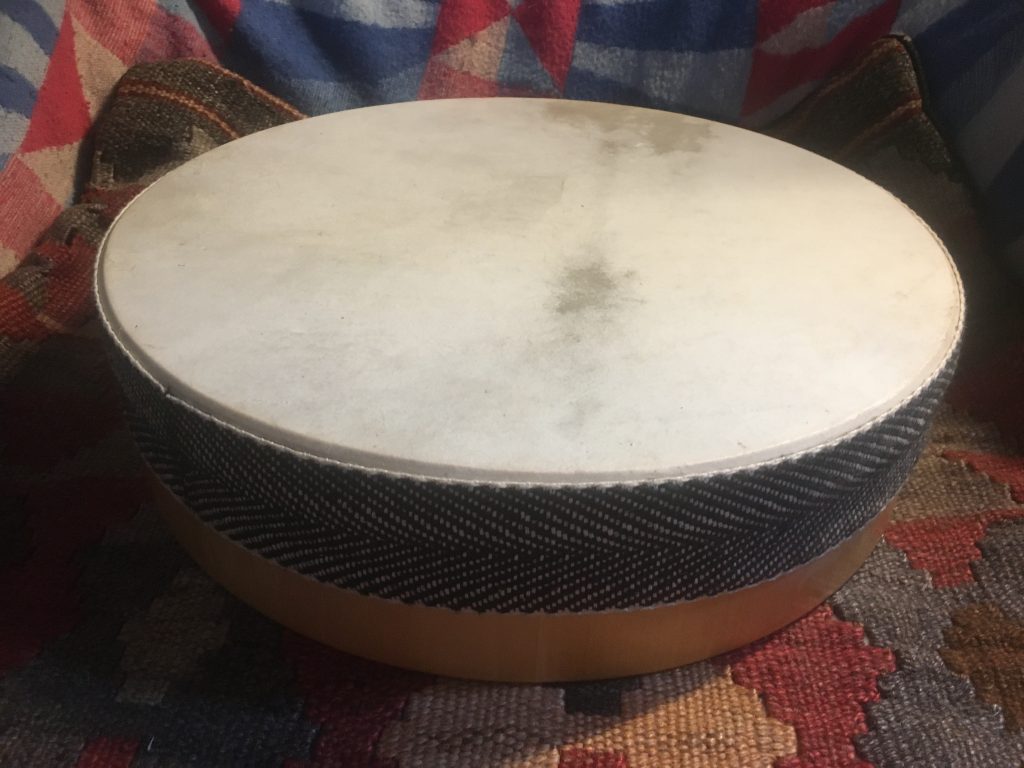
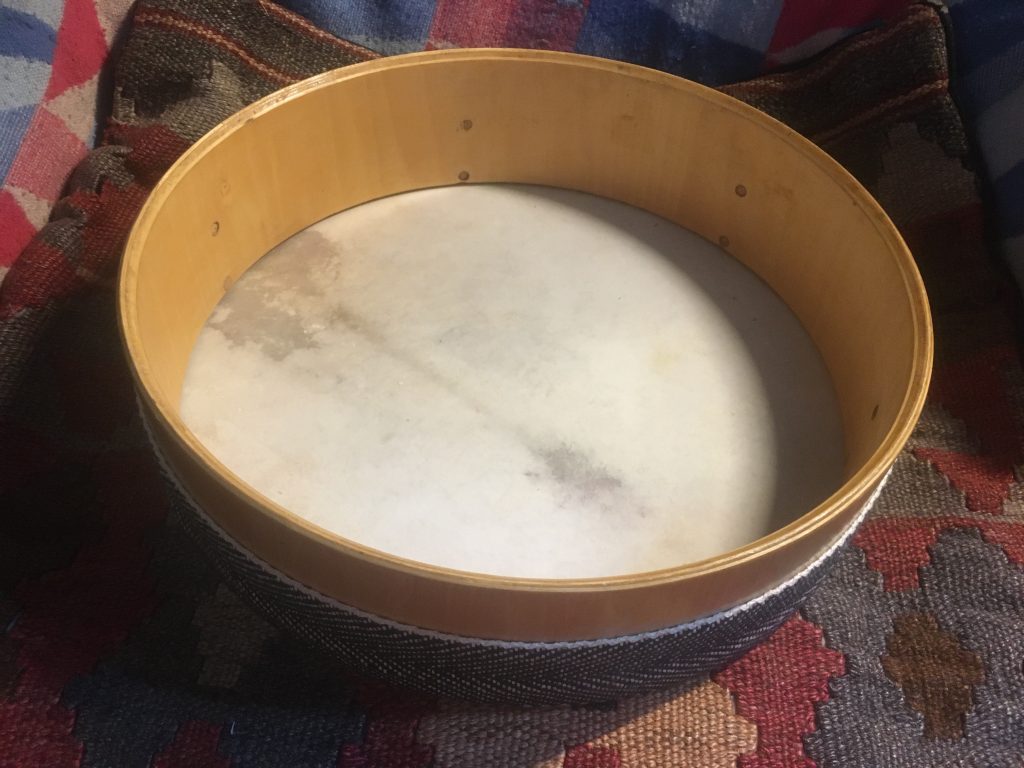
This drum, like the bodhran before it, was made from the shell of a drum, from an old drum kit. I have four complete drum kits, and lots of other sundry drums and bits ’n’ pieces.
I’ve always wanted to make my own drums – drum set drums, that is – in a variety of ways: stave construction, ply, or even solid shells. But I’m not at that point yet. For now working with existing shells is challenge enough.
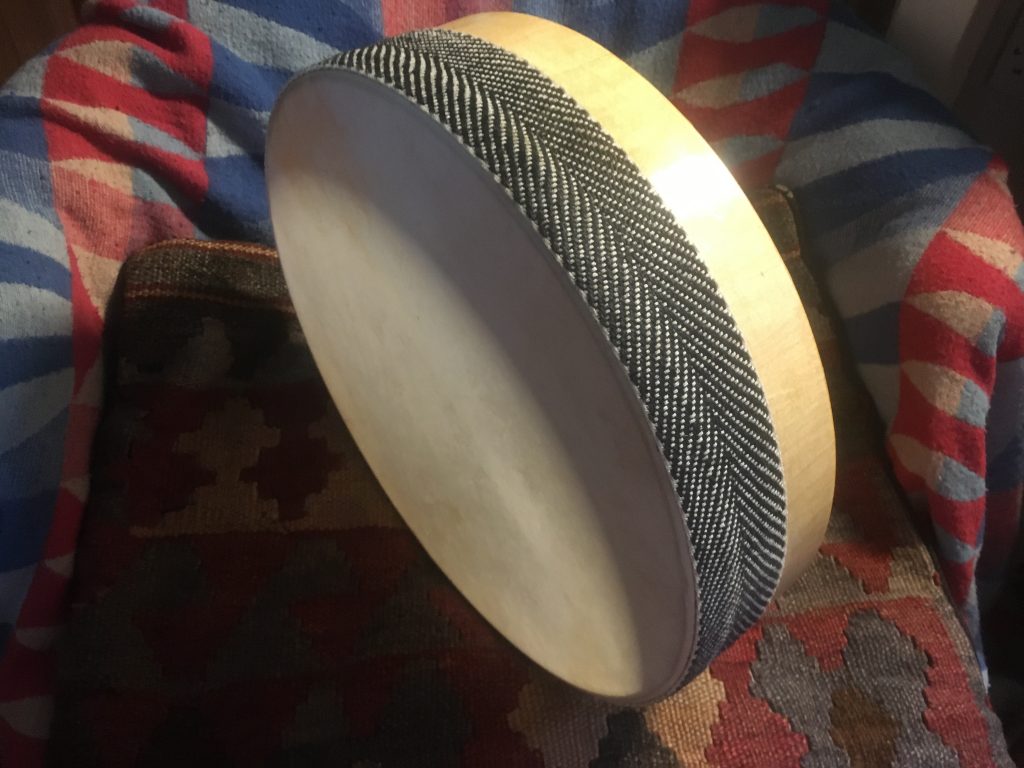
I spray painted Angus’ bodhran, in matt black. And then added numerous coats of silk lacquer. So it’s a little shiny, but not high gloss. This drum is just the wood, which I think is a maple outer ply, over birch inner plys.
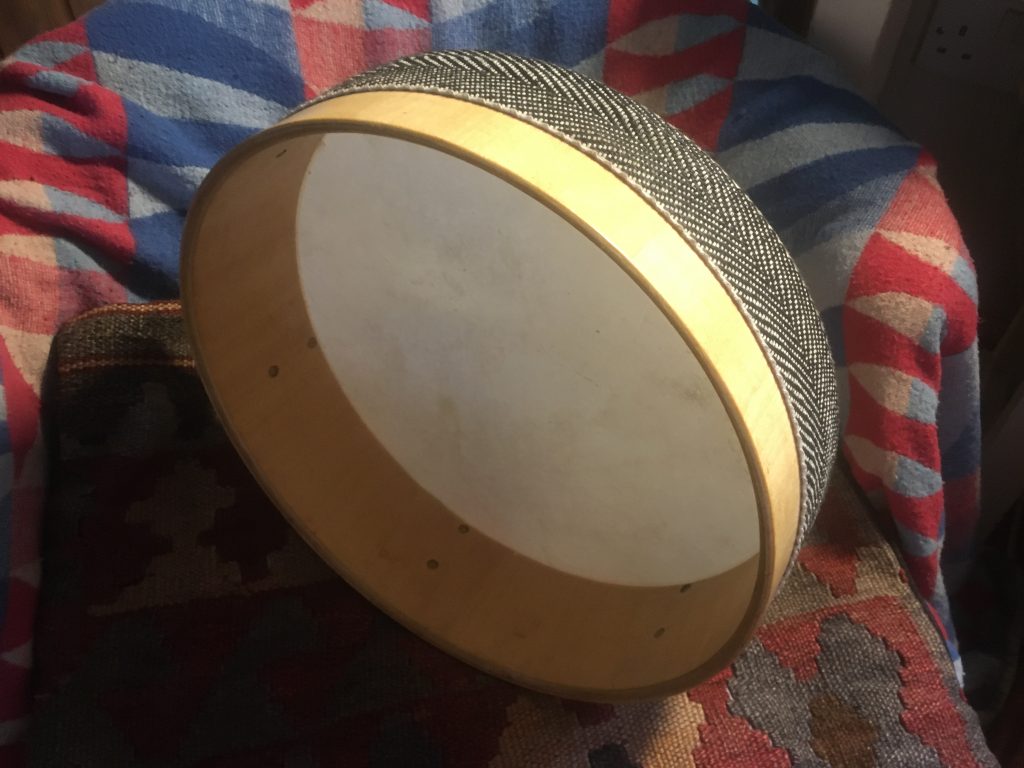
The skin is a goat skin, ordered off Amazon UK. When I made Angus’ drum, the skin arrived in a card tube. This one came only wrapped in a thin bin liner! Our kitten, Chester, smelt the gamey animal smell, and attacked. He shredded the packaging, and even chewed the skin itself.
Luckily he only nibbled one edge, and I was able to soak, stretch and glue it onto the frame, and cut away the damaged part.
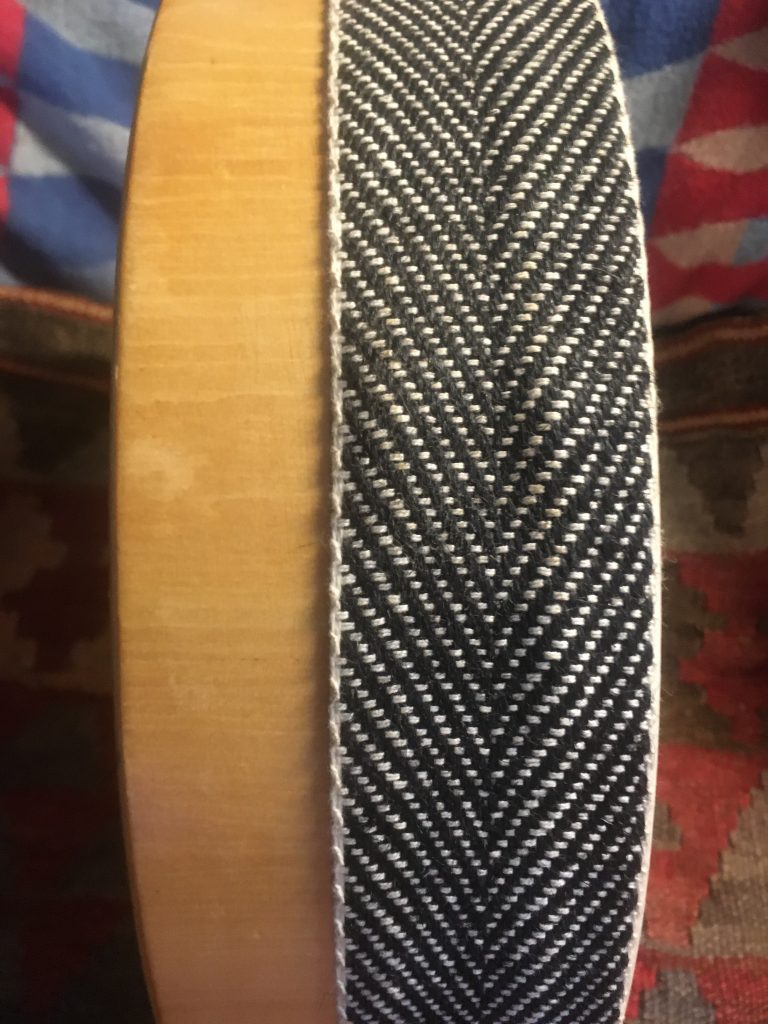
Both of the drums I’ve made so far have used this gorgeous black and white herringbone patterned ‘fabric tape’. I love it. But for future projects I may try skin variations, such as a patterned fabric.
Sometimes hand drums also have metal tacks, for a belt ’n’ braces approach to securing the skin. I’ve got some, but chose not to use them on this drum. Mostly ‘cause I just love the fabric. Herringbone textiles are my bag, baby!
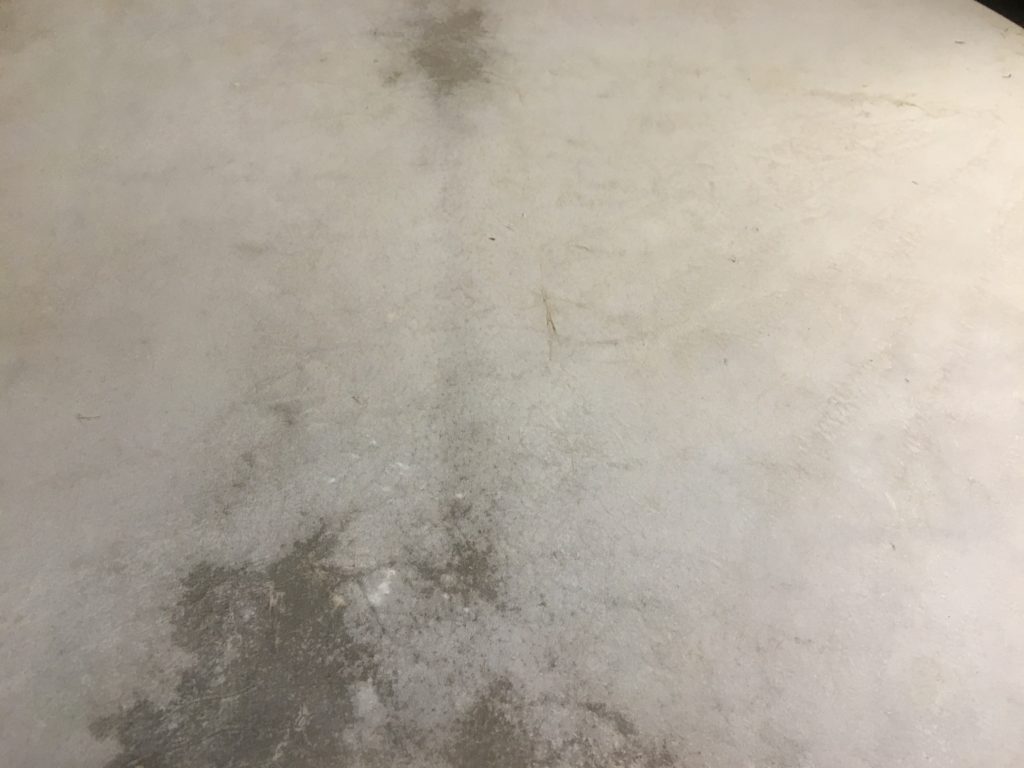
I’m keen to make some larger hand-drums, perhaps with a thicker heavier skin? I want to w able to get deeper bass notes than either of my 13” drums produce. But this still sounds great.
Unlike pretty much all kit drums, and nowadays a lot of hand drums, because the skin is glued on, tuning is kind of fixed. I say kind of because the tuning will change with heat and humidity.
HEALTH & WELLBEiNG: Intense Insomnia

The last three consecutive nights my normal nightly sleep has done a severe bunk. I will eventually sleep. But not until 5, 6 or even 7 am. Today, for example, I finally got to sleep around 6am, and then slept till midday.
These insomniac nights can really fuck up my mind. But the last three nights I’ve decided to try and ‘ride it out’. As that great funky sage James Brown frequently said; ‘what it is is what it is’!
POETRY/MUSiC: Upon The Hearth, Tolkien
Upon the hearth the fire is red,
Beneath the roof there is a bed;
But not yet weary are our feet,
Still round the corner we may meet
A sudden tree or standing stone
That none have seen but we alone.
Tree and flower and leaf and grass,
Let them pass! Let them pass!
Hill and water under sky,
Pass them by! Pass them by!
Still round the corner there may wait
A new road or a secret gate,
And though we pass them by today,
Tomorrow we may come this way
And take the hidden paths that run
Towards the Moon or to the Sun.
Apple, thorn, and nut and sloe,
Let them go! Let them go!
Sand and stone and pool and dell,
Fare you well! Fare you well!
Home is behind, the world ahead,
And there are many paths to tread
Through shadows to the edge of night,
Until the stars are all alight.
Then world behind and home ahead,
We'll wander back to home and bed.
Mist and twilight, cloud and shade,
Away shall fade! Away shall fade!
Fire and lamp, and meat and bread,
And then to bed! And then to bed!
In a fairly recent post about reading Tolkien, I said I much preferred his prose to his poetry. But I then posted about (?), a poem I adore, from The Lord of the Rings.
Another fabulous poem from the same work is Upon The Hearth. I don’t know if that’s the official name of the poem? But it’s what I call it. And it’s the title of the version so brilliantly set to a gorgeous simple tune by Stephen Oliver for the BBC R4 radio adaption (c. 1980?).
I’ve always wanted to do a version for guitar and voice. And I’ve attempted to do several times. But never with any success. Until today.
For some reason I decided I should try it using one of my favourite open-tunings; an open-C that Nick Drake uses on such songs as Pink Moon and Which Will.
And, with a degree of effort, I soon came up with some guitar parts that I think might eventually work. I’m definitely not there yet. But at least I’m on the way!
SOCiO-ECONOMiCS: Why Do The Poor Make … Poor Decisions
TED talk by Rutger Bregman
I don’t often watch TED Talks. I don’t know why, but I kind of took against them, early on. I think the reason I took against them was thanks to watching CEOs of large corporations doing the same sort of schtick.
It all seemed a bit vain and egomaniacal, and there was a whiff of evangelical smugness about the format. Look at me up here, a picture of success; sit at my feet, and hope that maybe you’ll pick up a few gems, the crystallised diamond beads of wisdom that drip off me!
The truth is, however, that the describe actually watched or listened to, have usually been quite good. Or at least quite interesting.
This popped up in my FB feed. I guess FB’s AI has learned me quite well. To my own surprise I decided to watch a bit. I was all too ready to dislike both speaker and subject.
But as I listened, I thought what he said sounded, well… sound. When he directly contradicts one of Margaret Thatcher’s basic tenets (‘poverty is a character defect’*), I start to like the guy.
This TED talk sounds rather like the prologue to a book length argument. And as such it feels like it lacks in depth and detail. But the basic idea, the basic argument, seems both cogent and – rather surprisingly, to me – quite uplifting.
The moral positivity such a philosophy requires, in a world currently ruled by the amoral heirs to Thatcherite strains of ideology – the ‘I’m alright, Jack’ and ‘dog eat dog’ mobs – is refreshing.
* Good God, Thatcher was an appalling idiot.
POETRY: The Road Goes Ever On, Tolkien
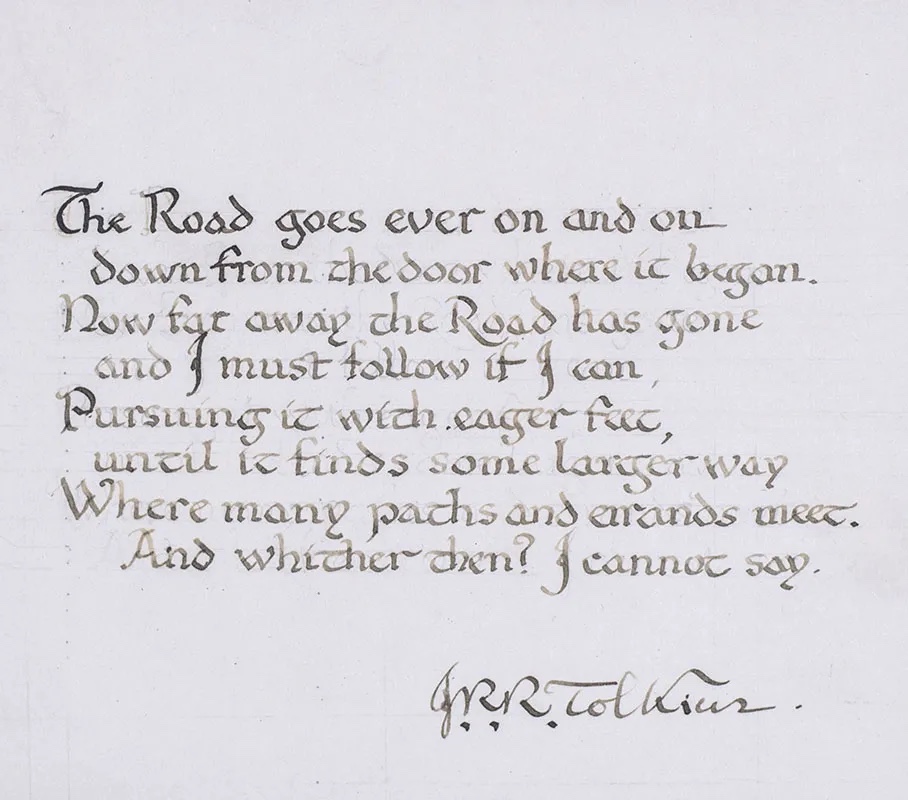
In a recent review of, I think, The Hobbit, I suggested I wasn’t so keen on Tolkien’s versifying. Whilst that occasionally holds good (for me), it’s far from universally the case.
The stuff I’m less keen on can be a bit twee. But sometimes his poems are, as in this case, sublime. This is lean, spare, and quite haunting.
The BBC Radio 4 adaptation, by Brian Sibley et al, set this verse to a brilliantly apt melancholic melody, by composer Stephen Oliver, which John Le Mesurier, as Bilbo, chants beautifully.
The version in Peter Jackson’s film is awful; way too light and fluffy – twee, in fact – despite being delivered by the wonderful Ian Holm (who played Frodo in the aforementioned radio adaptation). But it’s not the worst… oh no! See way down below, for the full horror.
The Road goes ever on and on
Down from the door where it began.
Now far ahead the Road has gone,
And I must follow, if I can,
Pursuing it with eager feet,
Until it joins some larger way
Where many paths and errands meet.
And whither then? I cannot say.
The poem, like Bilbo as he passes ‘into the night like a rustle of wind in the grass’ is, to revisit the phrase I love so much, both epic and homely. It’s also quiet, even melancholy. It’s quintessentially Tolkienian.
Most art I love, be it the writings of Kerouac, the early music of Tom Waits or Joni Mitchell, even the paintings of Guston or de Kooning, has this quality.
Apparently the Brazilian Portuguese word saudade is meant to capture or invoke just such a feeling. And verily, the bossas of Jobim, or the music of Joyce or Marcos Valle, do indeed have such qualities.
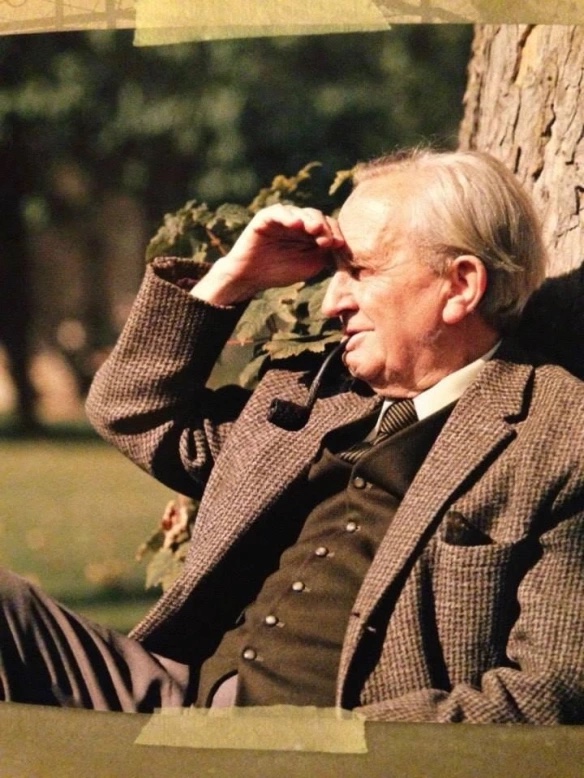
A sad footnote to the celebration of this poem itself is the appalling music by Donald Swann, the accompanist and co-conspirator in the terrific comedy/music duo that was Flanders & Swann.
Swann’s Edwardian after-dinner drawing-room recital type piano ditties not only fail to convey the right vibes, but render everything about these writings trite and ridiculous. They wash all the poetry and mystery out, replacing it with a porcelain knick-knack type of naff blandness.
Shocking!
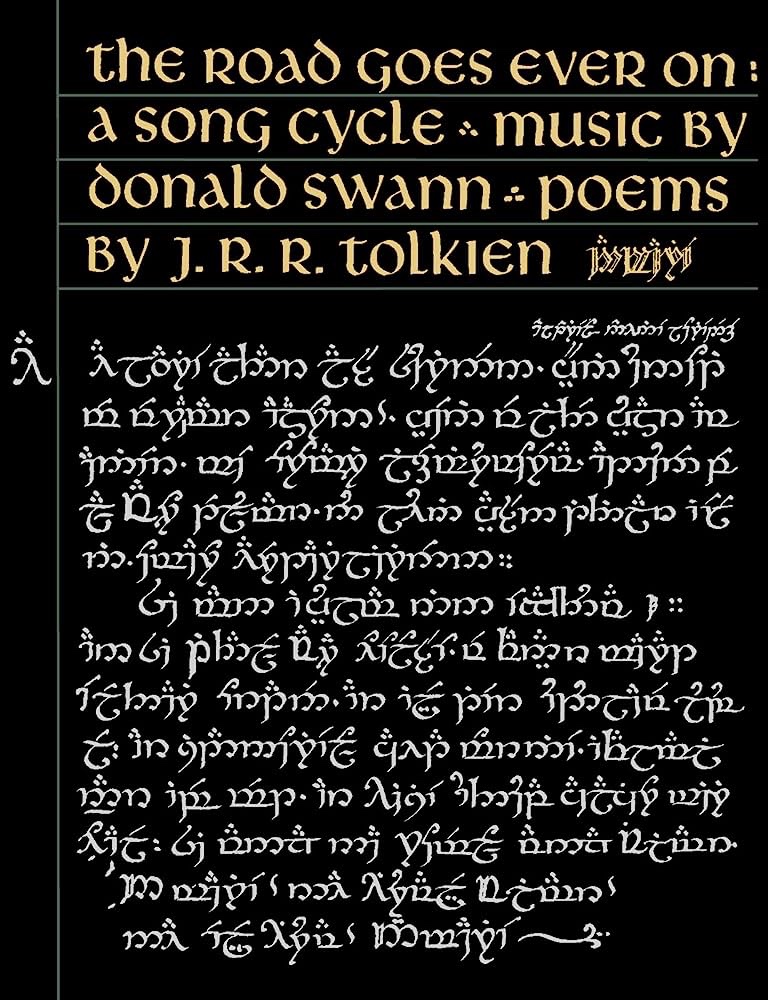
BOOK REViEW: The Art of The Hobbit, Hammond & Scull
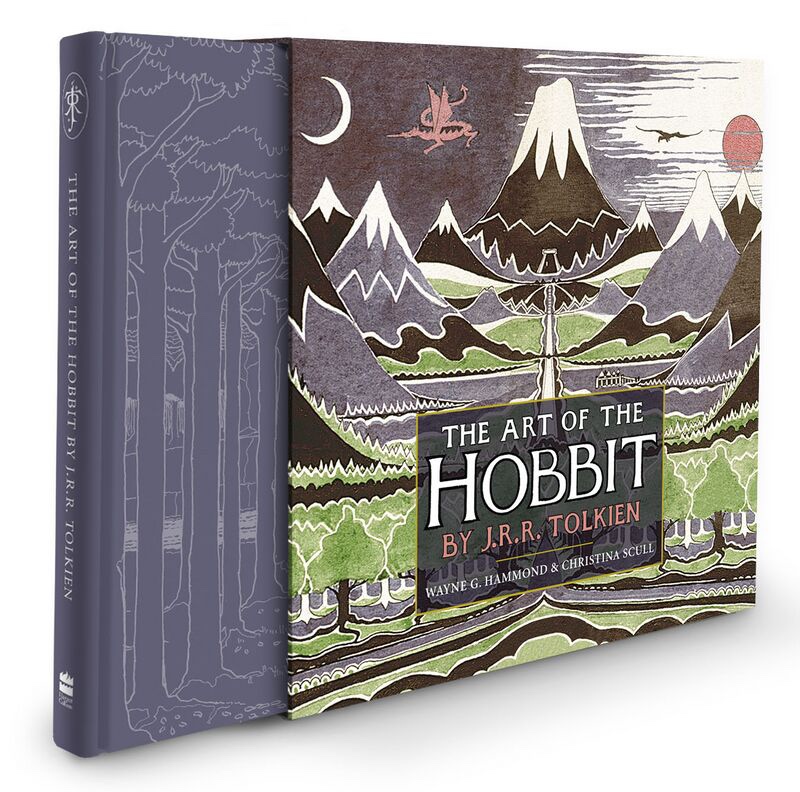

NB: This is an archival review, first written many years ago, during a period when I was part of the Amazon Vine programme. Although I didn’t get this book under that scheme. Sadly Amazon booted me off Vine, and deleted all my thousands of reviews! Some of them I had back-ups of. I’m putting those up here.
A marvellous gem of a collection
I love this book! It’s beautiful. For an ardent Tolkien-ophile like me it’s pure pleasure to read the erudite and informative text, or pore over Tolkien’s fabulous pictures. Tolkien’s best artworks are truly wonderful, and his maps and cover designs are all of a piece with his ‘gesamtkunstwerk’, the total work of art and imagination that is his special act of genius.
Definitely something for the buff, this book assumes knowledge of Tolkien and his world, including, very naturally, The Hobbit itself. It’s wonderful to learn more about the evolution of the book, for example the ‘Home Manuscript’, from which he read the story to his children, and in which illustrations played their part right from the beginning, and see how his maps, sketches, illustrations and design work, all fed into an ever-evolving creative process.
Learning about some of the specific triggers for Tolkien’s ideas, for example his ‘adventure’ in the Swiss Alps in 1911 that inspired the part of the story (and the corresponding illustration, ‘The Mountain Path’) in which Bilbo and his companions are in the mountains during a dramatic thunderstorm, or the historical buildings that inspired Beorn’s hall, or the lake-town of Esgaroth, is both fascinating and deeply pleasurable.
The print quality is superb, with details that were not visible in the various book-form publications of The Hobbit now clearly there to be seen and enjoyed, and augmented by much more in the way of sketches and related artworks. As just one example of how this ancillary material enriches the Tolkien/Hobbit experience, consider that Tolkien wrote a beautifully executed calligraphic version of Thorin’s note to Bilbo, in Tengwar script. This is so typical of the joyfully creative obsessional perfectionist streak exemplified in the whole of Tolkien’s creative work.
Bearing in mind this perfectionist tendency, it’s both endearing and plain wonderful that Tolkien, an amateur artist, was both able to provide this rich visual material to further enhance the experience of his imaginary world, and received the support of his publishers in doing so. Acutely aware of his own shortcomings (especially noticeable where he depicts figures), he didn’t let this stop him. His highly stylised images range from beautiful black and white pictures, such as the aforementioned ‘Mountain Path’, or the fantastic depiction of curling smoke contrasting with vertical tree trunks in ‘The Trolls’, to richly coloured pieces like the homely ‘Hobbiton-across-the-Water’, or the decoratively abstract adventurousness of ‘Bilbo Comes to the Huts of the Raft-elves’, this last apparently being Tolkien’s own favourite.
The richness of Tolkien’s conception extends to such things as beautifully stylised ornamental borders (often quite art-nouveau/deco in feel), the presence of his linguistic ideas in beautiful runes, or elvish scripts (both within and as borders to images), the use of maps both as aids to his own writing and illustration work, gorgeous evocative images in themselves, as well as for the reader’s use, and the design work he did for the book-binding and dust jacket, the latter being a superbly stylised three colour affair, which has lately and very understandably come back into vogue in the flurry of Hobbit anniversary editions.
If, like me, you own other books of Tolkien’s art, there is going to be some overlap and repetition (Tolkien’s complete artistic output is after all fairly small, and, barring new archival discoveries, not going to grow!). But having all the material relating to The Hobbit in one extremely handsome volume – and both the hardback itself, and the slipcase, are wonderful – is just fabulous. Like the shining Arkenstone atop the dragon hoard under the Lonely Mountain, so beautifully depicted in ‘Conversation with Smaug’ this book is a marvellous gem.
POETRY: Haiku, & Minimalist Haiku

Watch tennis
Rain drumming
On the roof
I came up with the above little mini-haiku earlier, whilst watching Alcaraz thrashing Chardy at Wimbledon.
I then thought I ought to look up what a real haiku is, form wise. Turns out it’s traditionally three lines: of five, seven and five syllables.
I wanted to change the name: a ‘hai’, or a ‘ku’? Or a haiku-ito (Jap-o-Spanglish?), or some such. But I couldn’t find any suitable Japanese diminutives!
Here’s the same poem, in the more trad form:
Watching the Tennis
The heavy rain falls drumming
Loud upon the roof
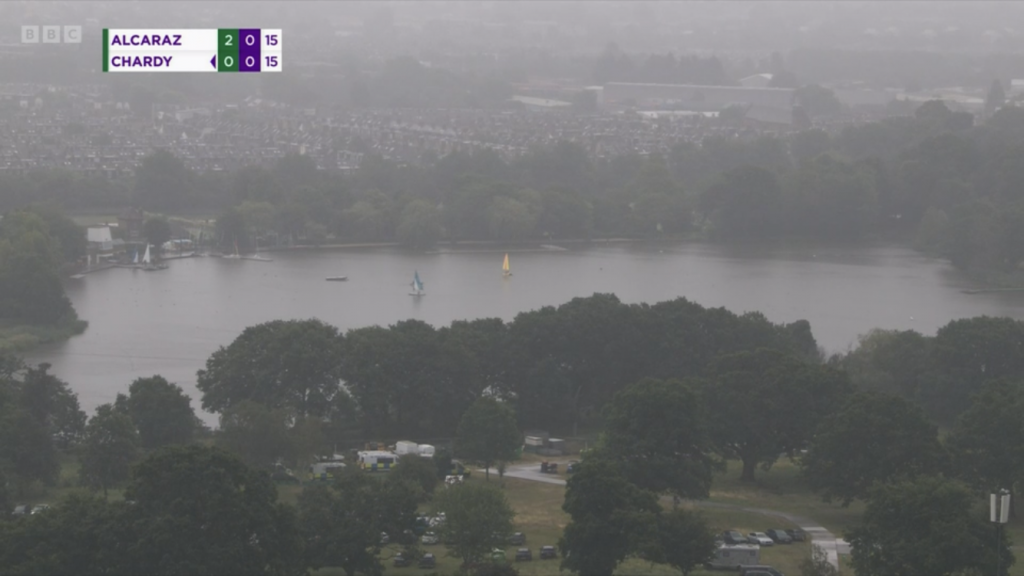
BOOK REViEW: Guardians of Being, Tolle/McDonnell
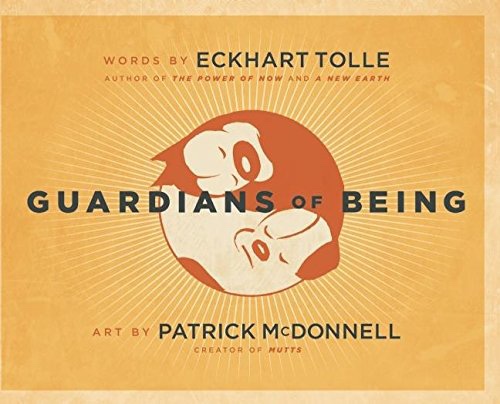

‘There is little or no magic about them, except the ordinary everyday sort…’ J.R.R. Tolkien, describing Hobbits (in The Hobbit).
You could say much the same about our pet cats and dogs, or even their ferile cousins. And yet we are so often besotted, bewitched and enchanted by our furry four-legged companions.
Equally, one could talk about studying literature, erudition, etc. Or one could speak of bibliomancy. Or just plain reading. Whatever way, words, images, thoughts, all have strange occult – as in unseen (yes, even images!) – powers.
Science may describe or unweave the rainbow. But reality is no less mind-blowing at the end of the day. And, truth be told, our pursuit of sciences actually makes the world ever more magical, considered from certain vantage points.
Anyway, this post touches on all these things, through the lens of Guardians of Being. Ordinarily I’m not that receptive to books in this line. Especially not when they’re imprints of Hay House. *
But yesterday, whilst tidying our blue room, with a view to letting it out, I re-discovered a book my mum gifted to me, back in 2015. I read it one sitting (30 minutes or less?). The text is very minimal.
And it was a good read for me at exactly that moment. And probably will be at many others. Perhaps I had to wait this long to get more from it? I had read it closer to the time I was first given it. And I enjoyed it back then.
But it spoke much more powerfully to me just now. Doubtless due to a much changed context.
In terms of reviewing this book, separate to what it’s meant to me in this particular moment (that experience was more ‘five star!), I’d give the imagery four stars and the text three. Hence three and a half overall.
I’m much more a cat than a dog person. Indeed, whilst dogs can be cute, their strong smell (cats have a divine subtle feline smell, which I adore), over intense attachment, and most especially their appalling barking, really put me off.
McDonnell’s style is not particularly to my aesthetic tastes. He’s clearly very good. And there are some excellent images. This is amongst my favourites, both visually and conceptually:
Perfect day pic
Eckhart Tolle I have more trouble with. I’m not big on new-age self-help gurus. They’re usually quacks and charlatans. Ulrich Leonard Tolle changing his name to Eckhart doesn’t lift his insights or pronouncements to any higher level. And some of what he says about animal consciousness here is open to scrutiny and debate.
Nevertheless, on a very basic level I’m totally in agreement with the core of what Tölle (which is apparently a German word naming ‘great’) is saying. One of my gripes with modern society is its failure to provide the space or means in which we can ‘just be’.
* Read more on this theme here…
